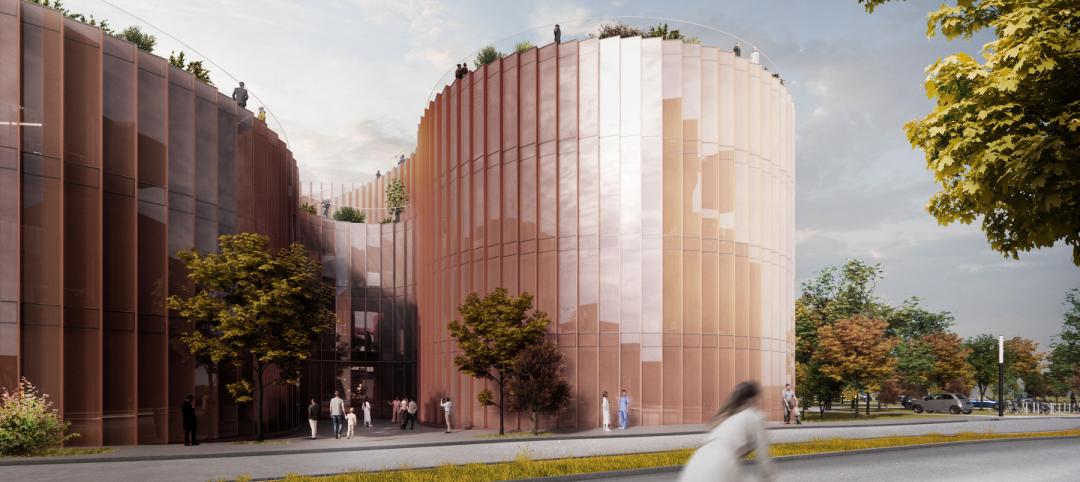The notion of open learning environments in higher education is trending, leading to the design of more collegiate buildings worldwide that are meant to remove barriers between students, faculty and disciplines.
Arizona State University’s Health Futures Center riffs on this popular design and educational idea, aiming to be a connecting place for interdisciplinary innovation, research, and medical simulation. Ground recently was broken on the facility, which is located adjacent to the Mayo Clinic campus, in northeast Phoenix.
The $80 million health care services facility will have a flexible framework, meant to support research and collaboration between the Mayo Clinic and ASU. The 142,000 SF building project’s groundbreaking was in April 2019; it is expected to be completed by late 2020. It is the first building on a new campus for ASU.
The building is meant to bring together the university’s College of Nursing and Health Innovation, College of Health Solutions, and the Ira A. Fulton Schools of Engineering, together with some shared programs of the Mayo Clinic.
The project was designed by CO Architects and DFDG Architects. CO Architects has expertise in developing such “hybrid” learning environments as is planned for the ASU facility.

“Our goal with ASU’s Health Futures Center is to create opportunities that maximize interdisciplinary collaboration and research in partnership with Mayo Clinic Phoenix, to help meet the mission of improving health outcomes,” says Jennifer Knudsen, AIA, LEED AP BD+C, Principal at CO Architects. “Our team designed the building to support a range of evolving interdepartmental research activities, industry partnerships, and teaching models through flexible, innovation-ready spaces.”
The under-construction building’s planned trapezoid façade is meant to decrease glaring from sun exposure on the structure’s east and west sides.
See Also: Sail on, Royal Caribbean: HOK-designed headquarters celebrates cruise ship industry
To speed work on the aggressively scheduled project, the CO/DFDG team collaborated with DPR Constriction’s pre-construction team, by way of the construction Manager at Risk method. The collaboration spawned a predictive cost-analysis tool, helping the project’s stakeholders prioritize needs and wants before the schematic design phase. This approach enabled the teams to design a building that fit needs and desires, and which will be within budget.
Through using Dassault Systemes’ 3DEXPERIENCE platform, the project’s designers streamlined and simplified the visual representation of the building’s complex geometry, enabling stakeholders to understand the structure’s design benefits.
CO Architects is the design architect, master planner, simulation planner, interior designer and laboratory planner for the building. DFDG is the project’s executive architect. DPR Construction is general contractor, ASE is serving as the structural engineer, Wood Patel is civil engineer, Jeremiah Associates, LLC, is performing AV/IT and acoustical, AEI Affiliated Engineers, Inc. is MEP engineer, and Floor Associates is performing landscape work on the project.
Related Stories
Projects | Mar 21, 2022
BIG-designed Danish Neuroscience Center will combine groundbreaking science and treatment
A first-of-its-kind facility, a new Danish Neuroscience Center in Aarhus, Denmark designed by BIG, will combine psychiatry and neuroscience under one roof.
Projects | Mar 18, 2022
Toronto suburb to build the largest hospital in Canada
A new hospital in Ontario will nearly triple the care capacity of its existing facility—becoming the largest hospital in Canada.
Projects | Mar 15, 2022
Old Sears store will become one of the largest orthopaedics outpatient facilities in the Northeast
A former Sears store in Rochester, N.Y., will be transformed into one of the largest orthopaedics outpatient facilities in the Northeast.
Projects | Mar 10, 2022
Optometrist office takes new approach to ‘doc-in-a-box’ design
In recent decades, franchises have taken over the optometry services and optical sales market. This trend has spawned a commodity-type approach to design of office and retail sales space.
Industry Research | Mar 2, 2022
31 percent of telehealth visits result in a physical office visit
With little choice but to adopt virtual care options due to pandemic restrictions and interactions, telehealth adoption soared as patients sought convenience and more efficient care options.
Healthcare Facilities | Feb 15, 2022
New outpatient ophthalmology surgical center opens in Newington, N.H.
JSA Design designed the project.
Resiliency | Feb 15, 2022
Design strategies for resilient buildings
LEO A DALY's National Director of Engineering Kim Cowman takes a building-level look at resilient design.
Healthcare Facilities | Feb 10, 2022
Respite for the weary healthcare worker
The pandemic has shined a light on the severe occupational stress facing healthcare workers. Creating restorative hospital environments can ease their feelings of anxiety and burnout while improving their ability to care for patients.
Coronavirus | Jan 20, 2022
Advances and challenges in improving indoor air quality in commercial buildings
Michael Dreidger, CEO of IAQ tech startup Airsset speaks with BD+C's John Caulfield about how building owners and property managers can improve their buildings' air quality.
Healthcare Facilities | Jan 7, 2022
Supporting hope and healing
Five research-driven design strategies for pediatric behavioral health environments.

















